How Advertising Works And Why AM/FM Radio And Digital Should Be Your Base Buy
Click here to view an 18-minute video of the key findings
Click here to view or download the slides
While local advertisers have a lot of different marketing options, a new analysis from Nielsen reveals that the most effective media plan consists of a base buy of AM/FM radio and digital solutions.
Here are the key takeaways from a review of respected marketing effectiveness insights and Nielsen’s new study:
- Marketing has two equally important jobs: converting existing demand and creating future demand.
- Since reach is the foundation of marketing effectiveness, adding media platforms grows reach and sales effect.
- Adding AM/FM radio to a TV + digital buy significantly grows reach.
- The addition of digital to an existing AM/FM radio campaign increases reach.
- The addition of AM/FM radio to an existing digital-only campaign causes reach to surge.
- Versus other media plans, an AM/FM radio base plan with digital extensions drives the greatest market reach.
How advertising works
Along with his writing partner Peter Field, Les Binet has been called a “godfather of marketing effectiveness.” Field is a world-renowned marketing consultant and Binet is the Global Head of Advertising Effectiveness at adamandeveDDB London. Here is their simple explanation of how advertising works:
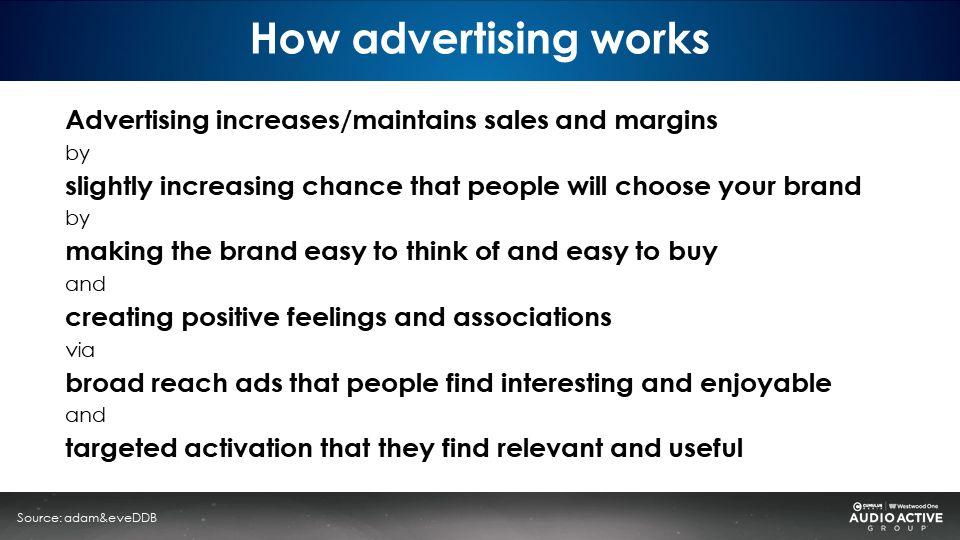
How does advertising work? Jon Lombardo, former Global Head of Research at LinkedIn’s B2B Institute, reports, “One of the primary things people misunderstand is how advertising works. People think they just put an ad in front of you and you immediately buy. That’s not how it works. Generally, you don’t generate any sale from an ad, what you do is generate a memory and then at some point later they consult their memory.”
The 95/5 rule: Only 5% of consumers are in the market at any time
The prestigious Ehrenberg Bass Institute of Marketing Science reports a very small amount of people are in the market for a product or service at any time. Whether it’s a home repair, an automotive purchase, health care need, or furniture, most people are not in the market.
Advertising needs to form around two key strategies. First, convert existing demand by reaching the five percent who are in the market. Usually that takes the form of a sales event.
Second, create future demand. Often this is called brand building. It focuses on the 95% of consumers who are not in the market, not thinking about the category, and not interested in a sales event.
The two jobs of advertising: Converting existing demand (sales events) and creating future demand (brand building)
Converting existing demand and creating future demand require different creative/copy approaches and different media strategies.
James Hurman is a globally recognized expert on brand building and marketing effectiveness, having spent much of his career researching, publishing, practicing, and teaching marketing effectiveness. Hurman has published the Kindle book, Future Demand: Why Building Your Brand Among Tomorrow’s Customers is the Key to Start-Up Success. You can order your copy here.
Hurman and the World Advertising Research Center have also partnered on a major study, Rethinking Brand for the Rise of Digital Commerce. WARC is the major global organization that devotes itself to the study of marketing effectiveness.
Converting existing demand is advertising to that small group of consumers who are ready to buy and capturing as large a share as possible of them for a product.
Hurman explains that creating future demand is advertising to that much larger group of consumers who are not in the market and are not ready to buy now but will be in the future. The goal is making them feel familiar with and positively towards your business in order to get them to gravitate toward you when they enter the category.
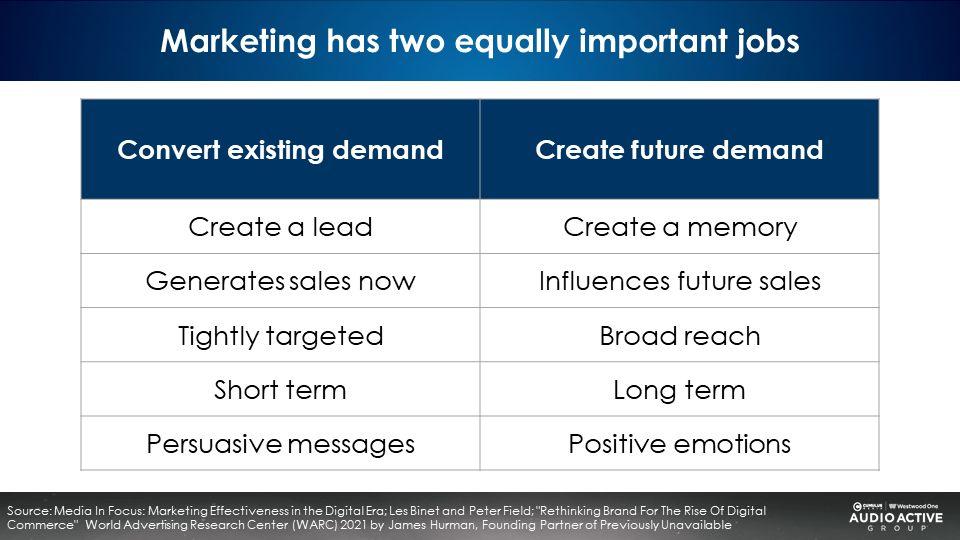
Converting existing demand has short-term impact but little long-term benefit
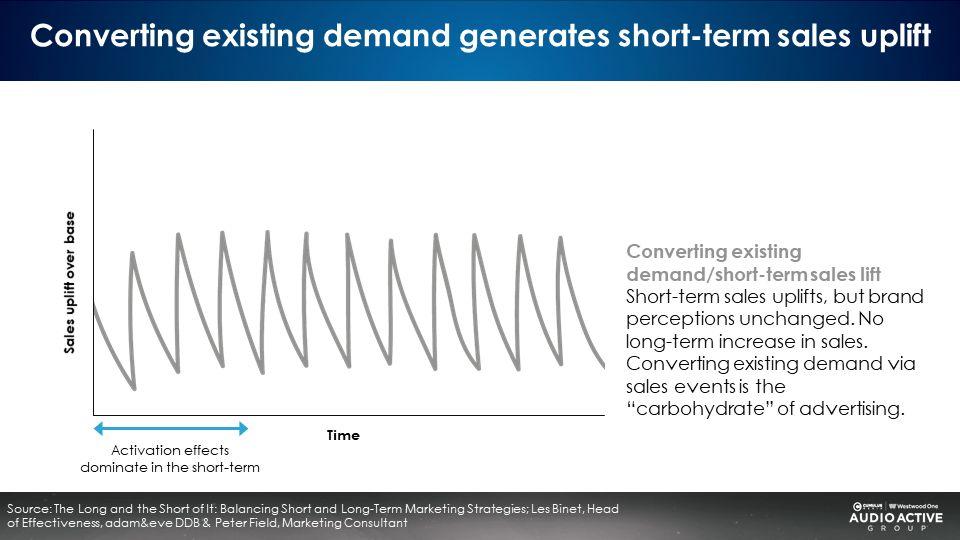
Sales events and promotions are the carbohydrates of advertising
Les Binet and Peter Field describe the sales effect of promotional strategies/converting existing demand in the above visual. Sales event advertising creates sharp short-term sales uplifts followed by quick drop offs. Promotional sales events generate sales “sugar highs” followed by quick crashes.
Creating future demand creates sustained long-term sales and profit growth
The grey line represents the sales effect of converting existing demand. The blue line represents the sales effect of creating future demand with brand building advertising.
Binet and Field recommend marketers allocate 40% of their marketing budgets to converting existing demand via sales events. They recommend 60% of marketing budgets be devoted to creating future demand via brand building advertising.
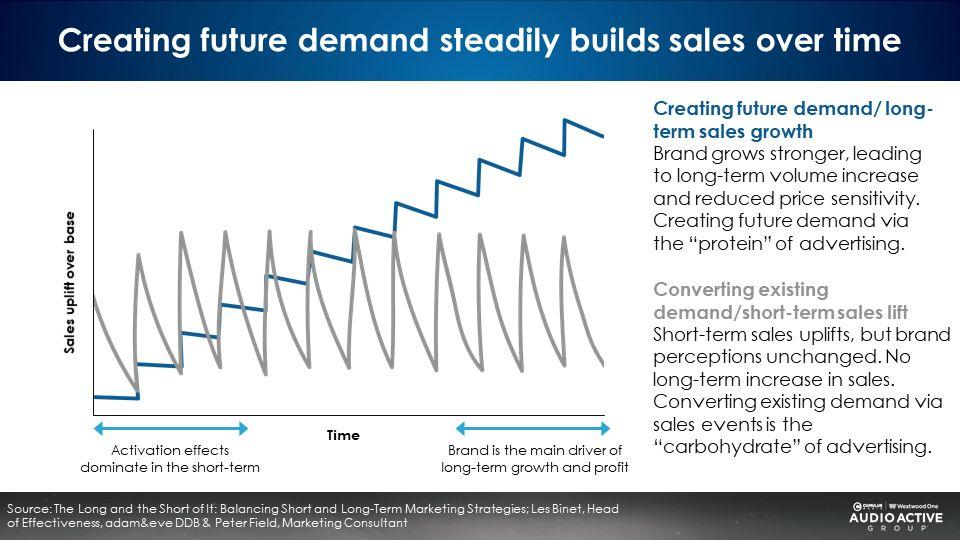
Creating future demand is the protein of advertising
As a business becomes better known, its brand grows stronger, leading to long-term volume increases and reduced price sensitivity. Creating future demand via brand building is the “protein” of advertising.
Creating future demand creates memories and memories generate sales; Clicks don’t generate sales
He continues, “This is in some sense the double benefit of brand. It’s more likely to come to mind and even if you do click, you’re still going to click on the strongest brand. It explains what’s really important in marketing is not bottom of funnel, lead generation clicks. It’s top of funnel, brand building memory. That’s the fundamental idea.”
Performance marketing “valley of death”: When converting existing demand dries up
Sales can plateau when demand hits a wall. Simply put, the sales event machine stops working when the supply of in-market consumers aware of a brand has been exhausted.
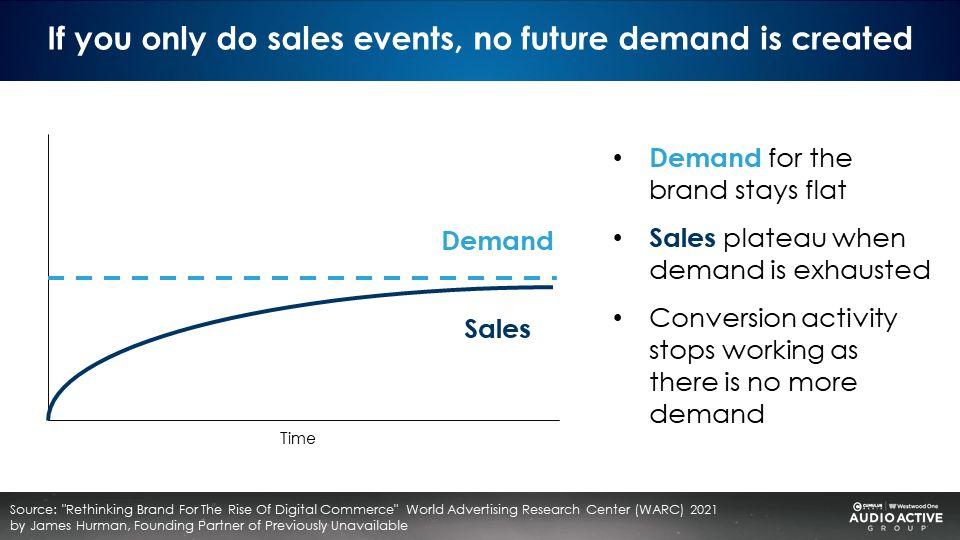
Firing on all cylinders: When a business consistently uses brand building to create future demand and sales events to convert existing demand, great things happen
According to Hurman and WARC, when future demand is created consistently, sales growth can be maintained. Successful businesses constantly plant new apple trees while picking ripe apples from orchards that have grown over time.
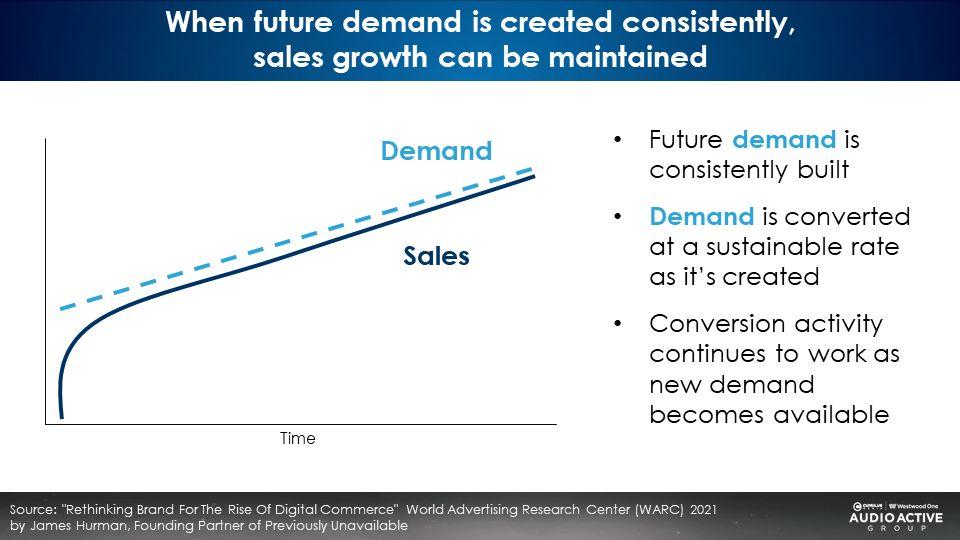
What is the effect of marketing investments over time? The “18-24-58” rule
Marketing media mix modeling firm Gain Theory published a major study entitled, Profit Ability: The Business Case for Advertising. Using the visual analogy of the iceberg, they report:
- Only 18% of marketing investment impacts the short-term month.
- 24% of advertising sales effect occurs from month two to month five.
- The vast majority of advertising impact (58%) occurs six months and beyond and represents advertising’s largest sales effect.
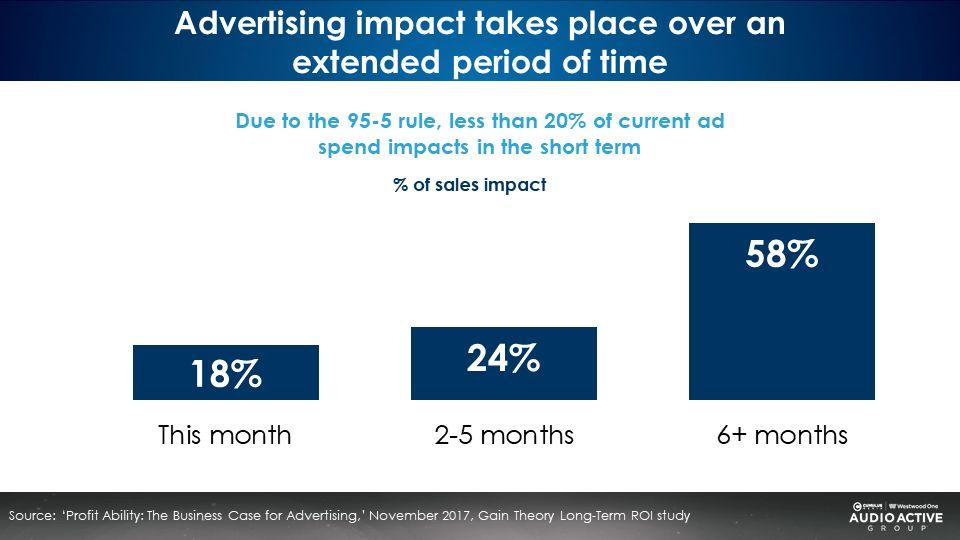
AM/FM radio + digital: The dream team of advertising creates future demand and converts existing demand
With its massive reach and ratings that rival TV, AM/FM radio is ideal for creating future demand and helping businesses create awareness and positive feelings. Digital solutions are perfect for converting existing demand by driving consideration and purchases.
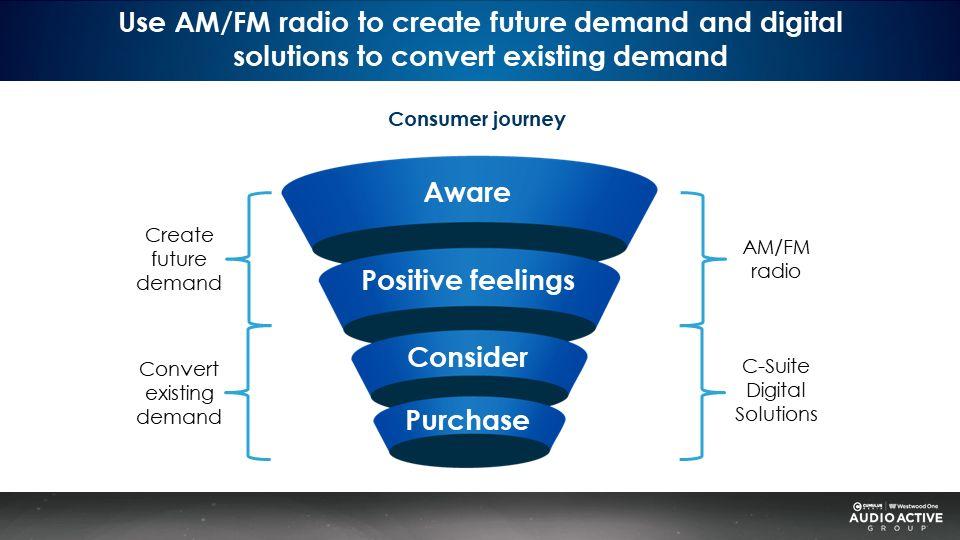
What happens when a portion of a TV + digital plan is shifted to AM/FM radio with no increase in budget?
A media plan consisting of 68% TV, 13% connected TV, and 20% digital reaches 59% of a market. 10% of the media plan is shifted to AM/FM radio. This generates a +28% increase in reach with the same budget.
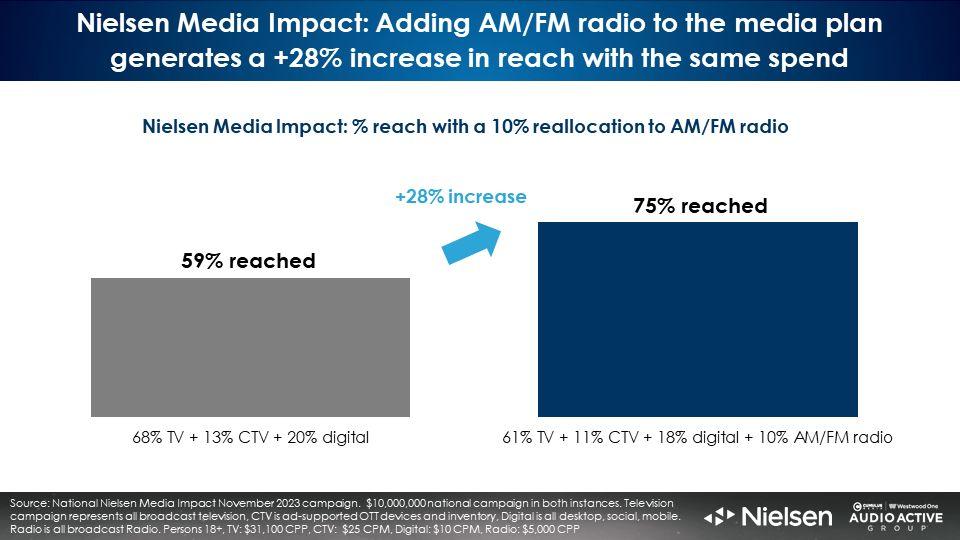
What happens when AM/FM radio is added to a digital-only plan at a 20% increase?
Three digital media plans with light, medium, and heavy investment were analyzed by Nielsen Media Impact, the media planning platform. Each digital plan was then supplemented with a 20% increase to fund AM/FM radio advertising.
In each scenario, the addition of AM/FM radio generates a significant increase in reach. In the case of the light digital media plan, the addition of AM/FM radio doubles reach.
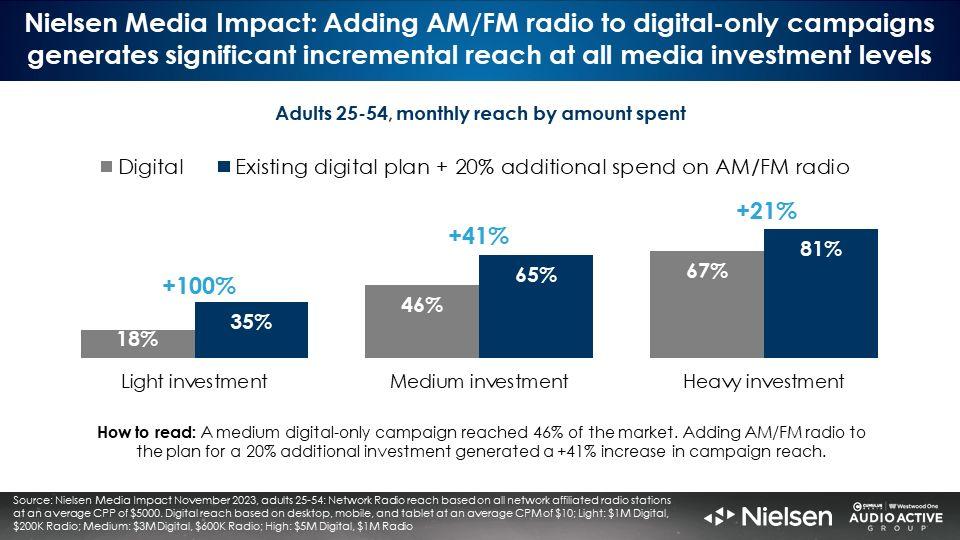
What happens when digital (online video and social) spend is added at a 20% increase to an AM/FM radio plan?
The same dynamic occurs when digital investment is added to four AM/FM radio media plans of various sizes. In all cases, reach increases.
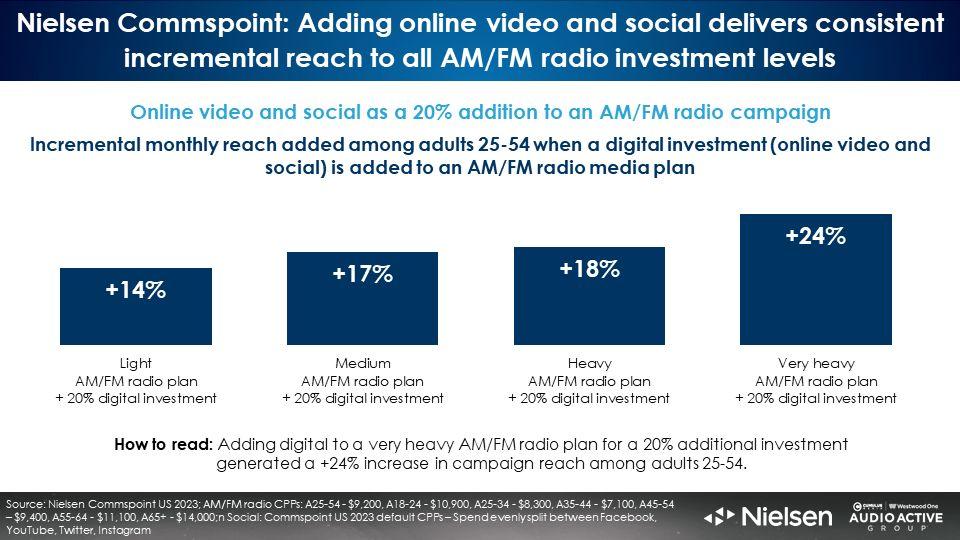
Which is the better plan? A base buy of outdoor, TV, print or AM/FM radio?
Four media plans with the same investment were analyzed by Nielsen Commspoint, the media planning platform. In each case 60% of the investment was placed in TV, outdoor, AM/FM radio, and print. The remaining 40% consisted of digital solutions and connected TV.
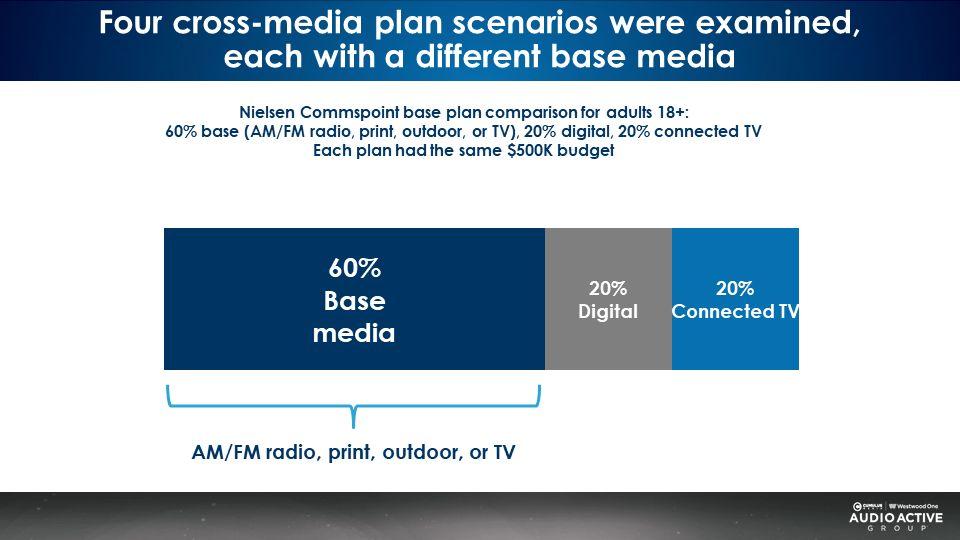
The winner: A cross-media plan with AM/FM radio as the base buy generates the greatest market reach
Surprisingly, the media plan with TV as the base buy has the lowest market reach. The AM/FM radio base buy has nearly double the reach of the TV plan with the same investment.
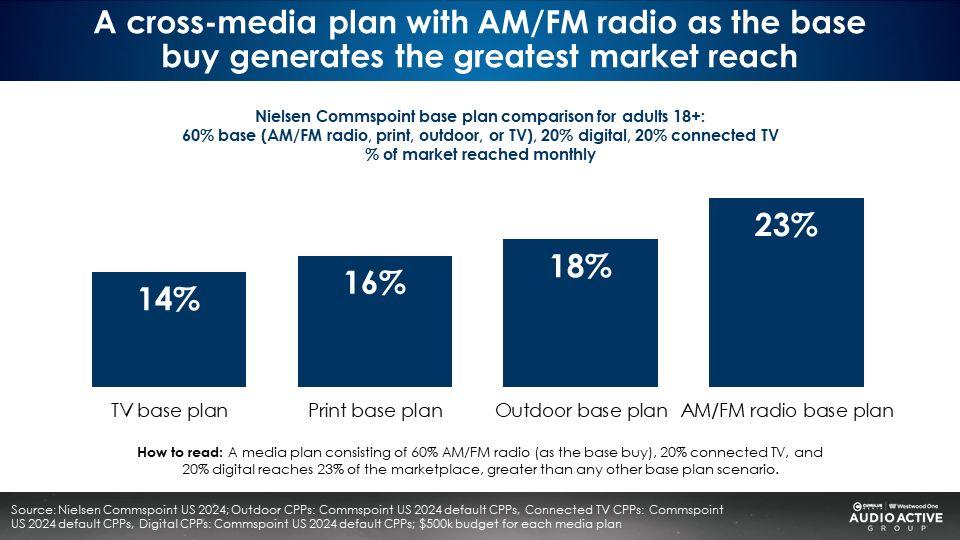
Why AM/FM radio? The powerful case for making AM/FM radio your base buy:
- AM/FM radio personalities build trust, community, and connection, creating emotional engagement.
- Audio ads outperform video for attention and brand recall.
- Reaching consumers on the path to purchase: AM/FM radio has an 86% share of ad-supported in-car audio, according to Edison Research’s Q4 2023 “Share of Ear” study.
- Consumers say AM/FM radio is the easiest to listen to in the car.
- According to Nielsen’s Comparable Metrics, AM/FM radio is the #1 mass reach media, creating future demand so brands can be “known before they are needed.”
- AM/FM radio significantly outreaches TV in all major demographics.
- AM/FM radio elevates the media plan with massive lift in reach across all demographics.
AM/FM radio and digital should be your base buy:
- Marketing has two equally important jobs: converting existing demand and creating future demand.
- Since reach is the foundation of marketing effectiveness, adding media platforms grows reach and sales effect.
- Adding AM/FM radio to a TV + digital buy significantly grows reach.
- The addition of digital to an existing AM/FM radio campaign increases reach.
- The addition of AM/FM radio to an existing digital-only campaign causes reach to surge.
- Versus other media plans, an AM/FM radio base plan with digital extensions drives the greatest market reach.
Click here to view an 18-minute video of the key findings
Pierre Bouvard is Chief Insights Officer of the Cumulus Media | Westwood One Audio Active Group®.